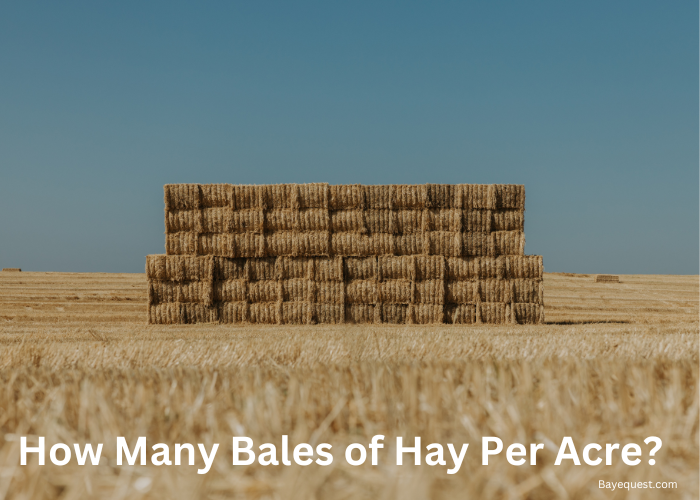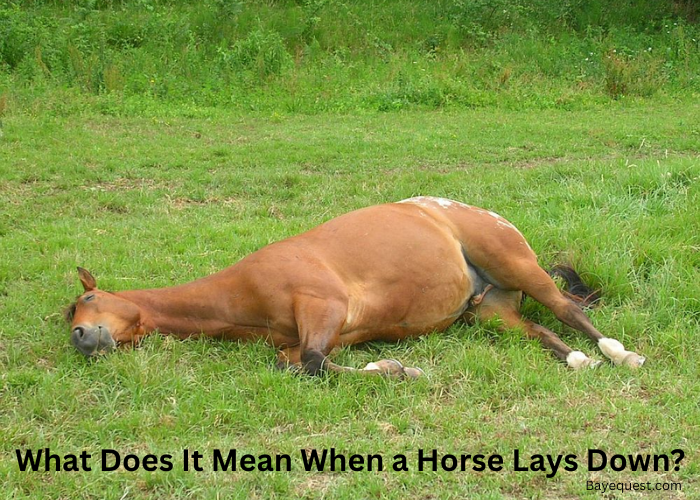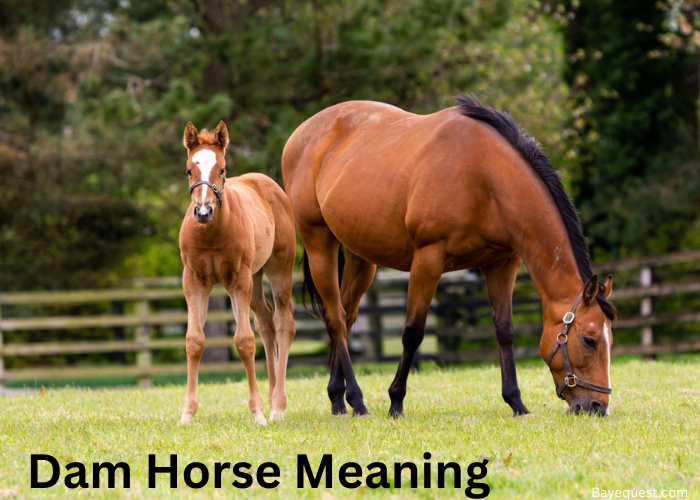Hay farming takes planning. The number of bales you get per acre depends on several things.
Soil quality matters. So does the type of hay you grow. Weather also plays a big part.
Some farmers get high yields. Others get much less. What’s the difference? It often comes down to how well you manage the land.
If you’re just starting or want to improve your harvest, this guide will help. Knowing what affects yield can make a big impact.
Let’s break it down and see how many bales you can expect per acre.
How Many Bales of Hay Per Acre Can You Produce?
The number of hay bales you can produce per acre depends on the yield and the type of bales you choose.
Hay yield per acre is measured in tons, and the size of the bales determines how many you can produce from that yield.
Small square bales weigh between 40 and 60 pounds. On average, one ton of hay produces around 50 small square bales.
If your field yields 4 tons per acre, you can expect to produce 200 small square bales from that acre.
Large square bales are much bigger, usually weighing 800 to 1,200 pounds each. One ton of hay results in about 2 to 2.5 large square bales.
This means an acre yielding 4 tons could produce 8 to 10 large square bales.
Round bales are another option, with small ones weighing 800 to 1,000 pounds and larger ones weighing up to 1,500 pounds.
One ton of hay generally makes 2 small round bales or 1.5 larger ones. An acre yielding 4 tons would produce about 8 small round bales or 6 large round bales.
The exact number depends on your bale size and field yield.
Factors that Influence How Many Bales of Hay Per Acre You Can Produce
Now, let’s explore what influences hay production the most:
Size and weight of a hay bale
The size and weight of hay bales greatly influence how many you can produce per acre.
Bales come in different sizes, including small square bales, large square bales, and round bales.
Small square bales weigh 40 to 60 pounds. Large square bales can weigh 800 to 1,200 pounds.
Round bales, commonly used for livestock, often weigh 800 to 1,500 pounds.
The type of bale you choose depends on storage space, equipment, and usage.
For example, smaller bales are easier to handle but take up more storage room. Larger bales require heavy equipment for transportation and stacking.
Your total bale count per acre depends on the bale size. An acre producing 4 tons of hay can yield 130 to 200 small square bales.
The same field might only produce 6 to 10 large round bales.
Understanding your needs is crucial when deciding on bale size.
Smaller bales are ideal for small-scale farming or easy handling. Larger bales are better suited for larger operations or long-term storage.
Choosing the right bale size and weight helps you manage your harvest effectively.
It also ensures you make the most of the hay produced on your acreage.
Hay variety
The type of hay you grow has a big impact on your yield.
Different hay varieties produce different amounts and qualities of hay.
Alfalfa is one of the most productive types. It can yield 5 to 8 tons of hay per acre under ideal conditions.
Grass hay, such as Bermuda or Timothy, usually produces 2 to 4 tons per acre.
Each variety has its advantages. Alfalfa is nutrient-rich and popular for feeding livestock.
However, it requires more care and better soil conditions. Grass hay is more adaptable and easier to grow but may produce less.
Choosing the right variety depends on your soil, climate, and goals.
The nutritional value of the hay also varies by type. Livestock often perform better on high-quality hay like alfalfa.
However, some animals, like horses, may prefer grass hay due to lower protein content.
Soil quality
Healthy soil is the foundation of high hay yields. Soil quality directly affects plant growth and, ultimately, the number of bales you produce per acre.
Fertile soil with balanced nutrients supports healthy plants. Poor soil results in weaker growth and lower yields.
Testing your soil is the first step. Soil tests can identify nutrient deficiencies and pH imbalances.
Most hay crops thrive in soil with a pH between 6.0 and 7.0. If your soil is too acidic or alkaline, adding lime or sulfur can correct it.
Fertilizers are essential for improving soil fertility. Nitrogen, phosphorus, and potassium are the primary nutrients hay crops need.
Organic matter, like compost or manure, also enriches the soil.
Compacted soil reduces plant growth by limiting root development. Aerating the soil helps improve water and nutrient absorption.
Regular maintenance, such as weed control and crop rotation, keeps the soil healthy over time.
Investing in soil quality pays off in the long run. Healthy soil produces stronger plants, increases yields, and reduces the need for extra inputs.
By focusing on soil health, you can maximize your hay production and get more bales per acre.
Length of the growing season
The length of the growing season determines how many cuttings of hay you can get.
A longer season allows for multiple harvests, increasing your total yield.
Areas with warm climates and mild winters often produce more hay per year than regions with short seasons.
Cool-season grasses, like Timothy and Fescue, grow best in spring and fall. They may only yield one or two cuttings in regions with short seasons.
Warm-season grasses, like Bermuda and Bahia, thrive in summer and can produce three or more cuttings in areas with long growing seasons.
Managing the growing season effectively is essential. Fertilizing and irrigating early in the season helps plants grow quickly.
Cutting hay at the right time ensures regrowth for the next harvest.
Weather patterns also influence the growing season. A late frost or early drought can shorten the season, reducing yields.
Monitoring weather forecasts and planning accordingly can help you make the most of your growing period.
Maximizing the length of your growing season requires preparation and care.
By timing your planting, fertilizing, and harvesting, you can boost your hay production and increase the number of bales per acre.
Farming practices
Your farming practices play a critical role in how many bales of hay you can produce.
Proper planting, fertilizing, and harvesting methods can boost your yield. Poor practices, however, can reduce production and waste resources.
Start with quality seeds. Using certified seeds ensures better germination and plant health.
Planting at the correct depth and spacing also helps plants grow evenly.
Fertilization is essential for healthy hay growth. Applying the right nutrients at the right time can improve yield.
Nitrogen is especially important for grass hay, while alfalfa benefits from phosphorus and potassium.
Irrigation keeps your hay crop growing during dry spells. Overwatering, however, can lead to root rot and wasted resources.
Weed control is another important practice. Weeds compete with hay for nutrients, sunlight, and water.
Removing weeds early prevents them from taking over your fields.
Weather conditions
Weather is one of the biggest factors affecting hay production. Rain, temperature, and wind all play a role in your yield.
Favorable weather can result in a bumper harvest, while extreme conditions can ruin your crop.
Rainfall is essential for hay growth but can be a challenge during harvest. Too much rain before cutting makes fields muddy and difficult to access.
Wet hay is also harder to bale and store, leading to spoilage. On the other hand, drought conditions can stunt growth and reduce yield.
Temperature affects plant growth rates. Cool-season grasses thrive in mild weather, while warm-season grasses need higher temperatures.
Extreme heat can stress plants, reducing their productivity.
Wind can dry cut hay quickly, which is helpful during baling. However, strong winds can damage plants or scatter loose hay.
Farmers need to adapt to weather challenges. Using irrigation during dry periods and monitoring forecasts for harvest timing are key strategies.
Having proper storage facilities also helps protect the hay from unexpected rain after baling.
Weather is unpredictable, but planning ahead minimizes its impact.
By staying prepared, you can reduce risks and maintain steady hay production.
Harvest time
Harvest timing is crucial for maximizing both the quantity and quality of hay.
Cutting hay at the right stage ensures healthy regrowth and better yields in subsequent cuttings.
For most hay types, the best time to harvest is when plants reach the pre-bloom or early bloom stage.
At this point, the hay has the highest nutritional value. Cutting too early reduces yield while waiting too long lowers quality.
Mature hay has more stems and fewer nutrients, which may not be ideal for livestock.
Timing also affects the drying process. Hay needs to dry properly before baling to prevent mold and spoilage.
Cutting hay during dry weather with minimal chances of rain ensures a smooth drying process.
Overcutting without allowing fields to recover can reduce yields over time. Proper intervals between cuttings help maintain plant health and regrowth.
Most farmers aim for three to four weeks between harvests, depending on the hay type and growing conditions.
Planning your harvest carefully boosts productivity and reduces waste.
The right timing leads to more bales per acre and better-quality hay, making it worth the effort and attention.
How Many Round Bales of Hay Per Acre?
The number of round bales of hay you can produce per acre depends on your field’s hay yield and the size of the bales.
Hay yield is measured in tons per acre, and the weight of each bale determines how many bales you can get from that yield.
Small round bales usually weigh between 800 and 1,000 pounds. A ton of hay (2,000 pounds) produces about 2 to 2.5 small round bales.
If your field yields 4 tons of hay per acre, you can expect to produce around 8 to 10 small round bales per acre.
Large round bales are much heavier, ranging from 1,200 to 1,500 pounds each.
A ton of hay produces approximately 1.5 large round bales. If your field yields 4 tons of hay per acre, you would produce about 6 large round bales per acre.
Fields with higher yields naturally produce more bales.
How Many Square Bales of Hay Per Acre?
The number of square bales of hay you can produce per acre depends on your field’s hay yield and the size of the bales.
Square bales come in different sizes, with small square bales being the most common.
Small square bales weigh between 40 and 60 pounds each. One ton of hay (2,000 pounds) yields around 50 small square bales.
If your field produces 4 tons of hay per acre, you can expect to get 200 small square bales per acre.
Large square bales weigh between 800 and 1,200 pounds. One ton of hay yields about 2 to 2.5 large square bales.
If your field yields 4 tons of hay per acre, you would produce around 8 to 10 large square bales per acre.
The exact number of square bales depends on factors like hay type, moisture content, and how tightly the bales are packed.
How to Estimate Your Hay Field
Estimating your hay field’s yield involves a few key steps to calculate production accurately. Here’s a simplified process:
Measure field size
Use GPS tools, mapping apps, or a measuring tape to calculate your field size in acres.
Identify hay type
Determine the variety (e.g., alfalfa, Timothy, Bermuda). Different types yield different amounts.
Perform a test cutting
Harvest a small section, weigh the bales, and estimate yield for the entire field.
Use local averages
Check with local extension offices or nearby farmers for average hay yields in your area.
Account for soil and weather
Adjust estimates based on soil fertility, rainfall, and overall growing conditions.
Calculate bale numbers
Divide your estimated yield (in tons per acre) by the average weight of the bales you’ll produce.
Tips to Maximize Hay Yield Per Acre
Maximizing hay yield per acre requires proper planning and effective farming practices.
By focusing on key areas like soil health, irrigation, and harvesting techniques, you can significantly boost productivity.
Here are detailed tips to help you get the most out of your hay field:
1. Improve soil quality
- Test soil for pH balance and nutrient levels regularly.
- Apply nitrogen, phosphorus, and potassium as needed to enrich soil.
- Add organic matter like compost or manure to maintain fertility.
2. Choose the right hay variety
- Select varieties suited to your climate and soil, such as alfalfa for high yields or Bermuda grass for warm regions.
- Opt for disease-resistant and high-producing hay types to maximize growth.
3. Use proper seeding techniques
- Seed at the recommended depth and rate to ensure even growth.
- Overseed regularly to maintain plant density and prevent bare patches.
4. Irrigate efficiently
- Provide consistent water during dry spells, especially during critical growth stages.
- Avoid waterlogging by monitoring field drainage and watering schedules.
5. Manage weeds and pests
- Remove weeds early to reduce competition for sunlight, nutrients, and water.
- Use integrated pest management to control harmful insects and diseases.
6. Fertilize at the right time
- Apply fertilizers during key growth stages for maximum impact.
- Use slow-release fertilizers for consistent nutrient supply.
7. Harvest at the optimal time
- Cut hay at the pre-bloom or early bloom stage for higher quality and better regrowth.
- Avoid late harvesting, as over-mature hay loses nutrients and yield.
8. Maintain equipment
- Keep cutting and baling equipment sharp and in good condition to avoid damaging plants.
- Properly calibrated equipment ensures cleaner cuts and efficient baling.
9. Rotate crops
- Alternate hay crops with other crops to prevent soil exhaustion and reduce disease risks.
- Use cover crops to improve soil structure and nutrient levels during off-seasons.
10. Monitor weather conditions
- Harvest during dry weather to ensure proper curing and prevent mold formation.
- Plan irrigation and fertilization schedules around local weather patterns.
How Many Hay Bales Per Acre? Conclusion
The number of bales you can produce per acre depends on many factors. Hay type, soil quality, and bale size all play a role.
On average, you can expect around 200 small square bales or 6 to 10 large round bales per acre.
Proper planning and farming practices can help you maximize your yield. Test your soil, choose the right hay, and harvest at the best time.
Every field is different, so monitor conditions closely. With the right care, you can make the most of every acre of hay.








